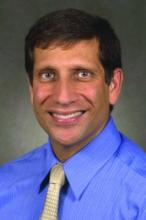NEW YORK – During the period 1996-2007, hospitalization rates for psychiatric disorders among American children aged 5-13 years rose dramatically, nearly doubling during that period.
Concurrently, psychiatric hospitalizations for U.S. adolescents (aged 14-19 years) also rose substantially, by 42%. During the same period, psychiatric hospitalizations rose modestly (by 8%) for adults aged 20-64 years, whereas psychiatric hospitalizations for Americans aged 65 or older fell dramatically, Joseph C. Blader, Ph.D., said while presenting a poster at the annual meeting of the American Academy of Child and Adolescent Psychiatry.
The reasons behind these changes and their implications for the quality of care American psychiatric patients receive remain unclear, said Dr. Blader, a researcher in the division of child and adolescent psychiatry at the State University of New York at Stony Brook. However, the shifts in hospitalization rates – especially the larger such shifts among children and adolescents – raise concerns that demand further analysis, he said.
"It’s not a good thing" that substantially more children and adolescents require hospitalization for psychiatric diagnoses, Dr. Blader said in an interview. The shifts "represent a significant development in mental health treatment in the United States," he said in the poster.
The data Dr. Blader analyzed came from the National Hospital Discharge Survey, and also showed that in 1996-2007, payment for the psychiatric hospitalizations underwent a significant shift away from private insurance coverage and toward an increased share of the hospitalizations paid for by government agencies, most typically Medicaid. Again, the implications of this – and how it might play into the increased hospitalization rates – remain unclear.
According to Dr. Blader, the questions now are, Does the rise in hospitalizations result from "problems in the level of services provided by community care," and has "more cost shifting" of patients into Medicaid from private insurance led to or resulted from the rise in hospitalizations?
"Beneficiaries of publicly funded inpatient care may have become disproportionately vulnerable to psychiatric emergencies," or perhaps the effect "indicates better outpatient care among the privately insured," he said in his poster. "In many states, privately insured patients with extended psychiatric hospitalizations become eligible for Medicaid coverage."
He noted that during the period studied, the psychiatric field has made a diagnostic shift: More children who engage in injurious behavior are being labeled with bipolar disorder. He also speculated that the increasingly complex polypharmacy treatment of psychiatric patients, including children, might be a factor boosting hospitalizations.
"When a child is on many medications and a crisis occurs, the physician may not be sure what to do, which drug to stop," and thus may feel it’s safer to hospitalize and manage the child or adolescent there, Dr. Blader said in an interview.
However, he dismissed the notion that clinical criteria for hospitalization shifted during the period examined. "It’s unlikely that there was a lower threshold for hospitalization" in 2007 compared with 11 years earlier, he said.
The National Hospital Discharge Survey, run by the Centers for Disease Control and Prevention, collected data from 366,000 U.S. hospitalizations in 2007.
Survey data showed that in 1996-2007, the rate of hospitalization for a primary diagnosis of a psychiatric disorder in children aged 5-13 years rose from 15.6 per 10,000 U.S. residents to 28.3. In adolescents aged 14-19 years, the rate rose from 68.4 per 10,000 to 96.9, while in those aged 20-64 years, the rate increased from 92.1 per 10,000 to 99.1. All of the changes were statistically significant. Dr. Blader’s poster did not report rates for patients aged 65 or older, but in his analysis, this number fell "dramatically" from 1996 to 2007, he said.
During the period studied, private insurance coverage of these psychiatric hospitalizations among children fell from 36% of cases to 23%, while government-based sources of payment rose from 63% of cases to 71%. Among adolescents, private payment fell from 52% of cases to 22% while government coverage rose from 44% to 62%. Among adults, private coverage fell from 36% to 23%, while government coverage was flat, at 58% in 1996 and 59% in 2007.
The impact of both increases in hospitalization rates as well as increased population levels also led to substantial boosts in total days hospitalized for primary psychiatric diagnoses among children and adolescents, but not in adults. For children, total hospitalized days soared from 644,461 in 1996 to 1,528,117 in 2007. Among adolescents, total days rose from 1,317,660 in 1996 to 2,115,905 in 2007.
Dr. Blader had no disclosures.


